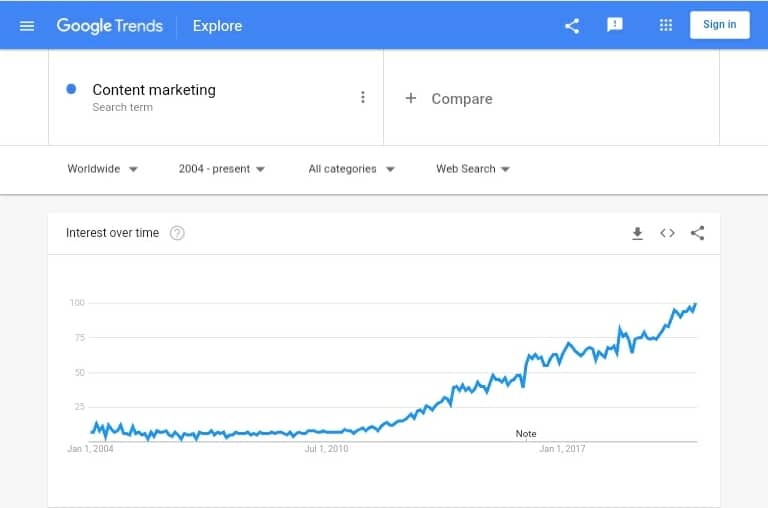As Business owners, our primary aim is always to increase conversion rates. As daunting as this task usually is with traditional marketing, this post features everything you’ll need to spike these rates using a Content Marketing strategy.
Below is a step-by-step guide to getting you started.
What is Content Marketing?
With the publicity content marketing’s had the past few years, tons of online sources have tried giving a suitable definition. However, no other source defines it better than The Content Marketing Institute:
… a strategic marketing approach focused on creating and distributing valuable, relevant and consistent content to attract and retain a clearly-defined audience — and, ultimately, to drive profitable customer action.
This means that
- the concept of content marketing is long term.
- It focuses on building strong audience and customer relationship.
- It achieves this relationship goal by feeding them with quality and relevant content.
This definition basically goes against everything we know about marketing. But as strange as the concept may sound to you, it’s not a new one. Content marketing goes way back to the era of comic books and storytelling.

Ever wondered why Marvel controls such a broad audience even with some recent shitty movies hitting the cinemas?
It’s because they already have the loyalty of these audiences. They caught their attention with relevant content (comic books) at a young age, and now it’s almost impossible to resist the movies.
These guys understood the concept of content marketing early enough and utilized it.
Well, lately, the tables have turned…..

Everyone now wants a piece of the cake.
And why is that? Because it works.
The concept of Content Marketing starts with generating high-quality and relevant content to a specified set of audiences. However, contents range from videos to ebooks, articles, podcasts, infographics, and so on.
For Marvel, high quality and relevant contents were the comic books; the specified set of audience were the kids, teenagers, and even some adults. Yea, don’t deny it.
For you, on the other hand, you’d have to figure that part on your own because it’s an essential piece of the puzzle. A simple market research would fix that.
Why do I Need Content Marketing?
Trust me, this question popped up at one point. I can literally hear you complain about the stress of going through all these when you can simply pay an influencer or run ads.
But here’s the thing, people are basically fed up with ads and the promises that come with them. Some have even found a way around it by using Adblockers. Your predecessors literally ruined your chances at gaining reasonable traction with ads.
Either way, Julia McCoy notes that:
a solid content marketing strategy can generate three times more leads than paid advertising.
What content marketing literally does is create a connection and loyalty with your prospects through valuable content. They get so immersed with your articles, videos, podcasts, and ebooks that they hardly notice when you silently chip in your products. Even when they realize this, they do not care at this point because the bond has already been established.
However, like you are used to, approaching prospects with ads straight up is more like coming in contact with a persistent marketer on your way back from work.
Annoying right?
So, each time you opt to run ads with unrealistic promises, you basically take the place of that persistent marketer on the street.
Read Also: PRODUCT MARKETING: Overview, Examples, Strategy, Job Description, Jobs (+ free courses)
Content Marketing Strategy
Content marketing strategies are a series of steps you take to research, generate, publish, and promote high-quality and relevant content.
A strategy in place is pretty vital to the success of content marketing. Furthermore, one of the many benefits of content marketing strategies is that they afford you the ability to create the right content at the right time.
Before the advent of the internet, content marketing methods were limited. All they had to go with were magazines, newspaper ads, and bandit signs.
But, in the face of this limitation, the early founders tried to find a way out. They devised means of generating relevant and high-quality content with the tools at their disposal. This included picture placement in newspaper/magazine ads and CTAs, choice of pictures, and playing with words.
Today we have tons of tools at our disposal, therefore quite a number of strategies in play. Regardless, only one of these strategies effectively works for all businesses and products alike. There are really no such things as a niche-based content marketing strategy like some people are led to believe.
Components of Content Marketing
Content marketing can take many forms, and in order to do it well, you’ll need to figure out what kind of content your potential customers love.
Blogposts
Create a blog schedule or strategy based on your content marketing approach. Other content can and should be cross-promoted on the company blog, which will help keep posts on a regular schedule. If you don’t have a member of your marketing team who is experienced with search engine optimization (SEO), this is an area where you should seek professional advice.
Ebooks
The content of an ebook should have a narrative framework and a lot of nice, visual design. Although the purpose of an ebook is to educate, it’s critical to choose language that is consistent with your brand voice.
Video
The key to making video work as part of a content strategy is to make it as timeless as possible so that you don’t have to constantly spending time and money on it. High-quality video material can also be used to bring your brand to the attention of YouTube’s enormous and engaged audience.
Infographics
Allow the images to tell the story rather than the text. Find a great freelancer that can create something attractive and informative if you don’t have an in-house graphics artist.
Cheat Sheets
Cheat sheets are a great way to save time. These are brief—no more than two or three pages. Because there won’t be much area for large photographs, you’ll want to employ text formatting to make them easier to scan. For more in-depth learning, link or point to other resources.
Workbooks and Templates
These resources are excellent for keeping your brand in front of buyers while also providing information. They should be printed-friendly and as engaging and useful as feasible.
White Papers and Reports
White papers and reports are similar to ebooks in that they are primarily educational, but they are often less visually developed and utilize more professional language. They can also open doors to collaboration with other groups.
Slide Decks
Slide decks are an excellent way to break down complicated concepts into small steps or bite-sized chunks. Keep the slides straightforward: Use a single typeface with limited text and large visuals throughout.
Case Studies
Create case studies that include genuine data and comprehensive stories. This will keep the content focused on the value and outcomes rather than the brand.
Demos
A free assessment, evaluation, or trial is a great way to start the conversation and completely qualify your most interested prospects. If you have an e-commerce product, you may utilize a discount code that customers can enter at the moment of purchase to create a sense of urgency.
Distribution Channels
Owned:
Using the brand’s own social media channels, such as Facebook, Twitter, LinkedIn, or Pinterest, to share your content is a quick, flexible, and cost-free way to engage with your target audience.
Organic:
Incorporating some SEO best practices into your content will help your website rank higher in Google’s search results. Providing the knowledge and answers that your target audience is seeking for is the power of a solid content marketing plan, so make sure they can find it.
Paid:
Paid advertising, including as sponsored content, pay-per-click (PPC), search engine marketing (SEM), display, and retargeting, is available on most social networks. Matching the demographics of a network to the personas of your brand will help you decide where to spend.
Earned:
This is the most valued, but also the most difficult to obtain. When your audience chooses to share your material with their network, you have earned social media exposure.
Five Case Studies in Content Marketing
There are as many different kinds of content marketing as there are different types of content, far too many to address in this article. My goal is to offer you an overview of content marketing and to get you thinking like a content marketer so that you can spot possibilities everywhere. You’ll soon be generating 50 content marketing ideas every day. You won’t be able to stop seeing possibilities for content creation. Here are five ideas to get your creative juices flowing.
#1. Infographics
Statistics, charts, graphs, and other data are typically included in these lengthy, vertical visuals. If you need some inspiration, Michael Schmitz, head of Publicis’ Munich’s Content Lab, has gathered 197 infographics on the subject of content marketing. Infographics are useful because, if done well, they may be shared on social media and posted on websites for years. You can acquire a professionally produced infographic by hiring a contractor on oDesk, or you can go with a firm like Visua.ly if you want to eliminate some of the risks.
A great infographic will normally set you back at least $1,000, but if you hire a contractor or agency to handle strategy and planning, research, copywriting, and design, it may set you back several thousand dollars. There’s also the issue of getting the infographic in front of bloggers and the press. Alternatively, you might create a Pinterest board and compile infographics on a topic relevant to your business. This is also a type of content marketing, and it only costs you time. It worked for Michael, after all.
#2. Webpages
What’s the difference between a regular website and a content marketing website? Consider Moz’s Beginner’s Guide to SEO, a collection of SEO tools and information. This free resource has been seen millions of times, bringing in numerous clients who would not have found Moz and the services they provide otherwise. Take a look at a case study by Teehan+Lax, a design studio. The majority of case studies are tedious. Their case studies are quite interesting. That is the distinction between merely adding content to your website and content marketing.
#3. Podcasts
Michael Hyatt, the best-selling author of Platform: Get Noticed in a Noisy World, is a living example of what he preaches. Every month, 250,000 people listen to his podcast “This is Your Life.” “A podcast provides you awareness in a completely other world—primarily iTunes,” Hyatt writes in his blog piece 4 Reasons You Should Consider Launching Your Own Podcast. Hundreds of new people have told me they had never heard of me until discovering me on iTunes.” Hyatt’s podcast is full of useful information and guidance, and it’s all free. However, the podcast leads to additional book sales, course registrations, and invitations for him to speak.
#4. Videos
Take a peek at Gary Vaynerchuk’s YouTube channel to see how he uses internet video for content marketing. He began by making movies to advertise his family’s wine shop, which he later developed into a $45 million empire through those videos and other web marketing. Because many believe videos and podcasts are expensive and difficult, they are mostly unexplored forms of content marketing. However, with the decreasing cost of professional-grade equipment, producing high-quality video and audio content has never been easier.
Blenders, innovative dental products, and Hong Kong visa consultancy services have all benefited from amateur video content marketing. What video could you make for your firm that could completely transform its fortunes? It could be a lot simpler than you think.
#4. Books
People frequently think of books as selling themselves, similar to movies, but effective marketers don’t sell books for the sake of selling books; instead, they sell books as marketing tools. While I’m sure Michael Port enjoys selling his book, the book is a tool for directing customers to his coaching and speaking services. Despite the fact that self-publishing has made it easier than ever to publish a book, there is still a sense that it is difficult and that only respected professionals can do so.
Publish your own, and even if no one reads it, you can still use it as a sort of content marketing whenever you’re referred to as the “Author of…”
These are just a few content marketing examples. White papers, ebooks, apps, public speaking, presentations, and blogs might also have been mentioned. Each of them has been the subject of entire books on how to use them in content marketing.
How to do Content Marketing
Considering the several complications with strategies on the internet, I have carefully outlined progressive steps to get you started on the right path.
Research Relevant Keywords
Before you start out with generating content, you might want to know the needs of your target audience. Recall our use of the phrase high-quality and relevant content. It is almost impossible to achieve this without thorough keyword research. You literally win their hearts by producing content that aligns with their needs or solves their problems.
Furthermore, in this line of business, you totally want to avoid generating content based on guts, feelings, or personal likes.
Now when an internet user types a string into the Google search box, they unconsciously use keywords. These keywords give you an idea of their needs and help you build content around that need while chipping in your products as a solution.
However, a great tool to get you started is Ubersuggest.
Take this like killing two birds with one stone. Most products or content solve more than one problem. So, finding related keywords puts you in the position of meeting more than one need with your content. This in turn increases your conversion rates.
On the other hand, using just one keyword could make your content sound stale. You need to create your content in a way that is clear and understandable to both google and readers. It helps your audience flow with your articles and helps Google understand what type of search intent to target.
This is totally achievable by using related keywords. Ubersuggest can also help with this too.
Get Spreadsheet for Each topic
Remember your major objective for keyword research is to enable you to build topics around the needs of your audience.
At this point designing a spreadsheet is paramount. It helps you organize your findings which you would be needing for each topic. Ranging from target keywords to related keywords and every other necessary information for content generation.
To skip this step of content marketing strategy could prove lethal because getting organized right before content creation is key to effective delivery.
Read Also: Relationship Marketing: The A-Z Guide (+ Free Tips)
Create a Checklist for Each Content.
Checklists may sound like clichés but for the first time, this cliché is one you cannot overlook. They help with organizing your ideas and structure.
Furthermore, they also help with deciding specific subtopics to cover which helps you deal with your inability to remember ideas most times.
However, this checklist should be embedded in your spreadsheet. Each topic carries subtopics, links, and statistics you would want to mention.
Save Your contents on Drafts
Contents are not usually 100% perfect immediately after creation even though they look like it. Come back to the same article 2 or 3 days later, you’d realize this. There are two ways to go about this though; Proofread after two days or send it to a professional editor.
This is pretty vital because contents with grammatical, logic and other issues sends out a wrong message about you especially to new visitors. Remember the thing about first impressions.
So, saving your content on drafts gets you ahead of issues like this. Tools at your disposal include Microsoft Office, Google docs, WPS, or any program you feel comfortable with.
Just ensure you hold the urge to hit publish a few minutes after creation.
Get a Schedule for Publication and Promotion
Consistency is a key factor in content marketing; more important than frequency. The thing with being frequent is, most times, the need to meet deadlines prompts you to overlook some mistakes or leave out vital Infos that would have been of value to your audience.
So, you would need to maintain a consistent schedule to enable you to cover all your bases on each topic. A published schedule could range from twice a week to every weekend or even every day of the week. That way your audience knows exactly when to come back for new content.
However, one great feature about most publishing platforms like YouTube, BlogSpot, and WordPress is that they allow you to schedule publish dates. So even when you finish a content before the proposed date, you can automatically schedule the content to publish without coming back to hit the button.
On the other hand, posting about your new content before or after publication could make a huge difference in your conversion rates. Tools like Buffer or Facebook help to make promotion schedules easier.
Always Reach out To Influencers
There is such a thing as Influencer Marketing, a basic addition to your post-content marketing strategy. It basically involves reaching out to top brands mentioned in your content, asking them to share your content. Although, follow-ups are usually slow at this point however the more people you contact, the higher your chances of getting your content shared.
These people literally wield the power to make your content go viral. Another advantage is that they share your content with like-minded or related audiences.
However, while there’s nothing wrong with asking for a share, avoid pestering Influencers. A better approach would be to build a relationship with them. More like asking for something you could do in return for sharing your content.
Read Also: Target Marketing: All you need to know
Do not Joke with Internal Links
Ranking better on SERPs (Search Engine Results Pages) is always in synergy with internal links (links to other content on your platform). When visitors click on your content from SERPs, an important factor Google considers is the amount of time spent on your content. It tells how relevant your content was.
However, if they left as quickly as the link was clicked, it automatically affects your ranking.
So, Internal linking helps you keep them a little bit longer, although not relenting in your efforts at creating high-quality and relevant content.
But starting out with a content marketing strategy from the scratch means you do not have existing content. This however fixes itself along the line as you keep creating newer pieces.
A great tool for achieving this is the Yoast plugin on WordPress. It automatically suggests related pieces available on your platform.
Planning, Implementing, and Optimizing Your Content Marketing Program
While content marketing is a long-term plan, each of these steps is critical to ensuring that you have a solid foundation in place to set yourself up for success.
Step 1: Create Your Key Persona Profiles
What kind of material are you looking for? Your buyer personas will help you define your target audience—their issues, questions, and desires, as well as the types of content they prefer to consume—while their buying stages will tell you what each piece of content should achieve.
Step 2: Learn About Their Buying Process
A buying journey is a diagram of a buyer’s decision-making process during a purchase that will assist you in determining what information you require. Different types of material appeal to different types of purchasers at various phases of the buying process. You’ll gain a better understanding of the process purchasers go through while contemplating your product or service if you map out your buying stages. As a consequence, you’ll be able to create a content strategy that speaks directly to consumers, regardless of where they are in the buying process.
Step 3: Create a Content Marketing Strategy After Brainstorming
It’s not just about mapping and metrics when it comes to planning and developing fresh content. One of the most difficult and vital aspects of content development is brainstorming and asset planning. You’ll need a receptive environment and a team-wide willingness to try new things to grab inspiration when it strikes. An editorial calendar is a strategic tool that helps your team execute integrated plans that involve your content. It is not just where you keep track of, coordinate, and share your upcoming content; it is also where you keep track of, coordinate, and share your past material. Using an editorial schedule ensures that your material is released at the greatest possible time and that your entire team is on the same page.
Step 4: Write Your Content and Optimize It
You’ll want to get the most out of every asset if you’re starting with original, high-quality content that you’ve spent actual time and money creating. You’ll also want to make sure your material is up to date and relevant—out-of-date or irrelevant content might damage your brand’s credibility. Remember the three Rs to make sure you’re getting the most out of your content marketing:
Reorganize:
This isn’t only a smart approach to reach members of your audience who want to consume material in different ways—also it’s an effective way to put out fresh content. Some of the people you’re selling to could prefer ebooks, while others might prefer infographics, and yet others might prefer slide decks to learn from. You can reach more people with less effort by slicing and dicing.
Rewrite:
Mark an asset for a future update whenever it consistently performs well. The number of engagements will eventually start to decline, signaling that it’s time to update.
Retire:
Even the best stuff can’t last indefinitely. It may be time to discard a content asset that requires more than a design refresh or a basic update. Content that has passed its expiration date tarnishes your company’s authority and trustworthiness, effectively undermining all of your hard work.
Step 5: Go Live and Fine-Tune
Because each stage of the funnel has various aims, content at each stage should be measured accordingly. The following are the fundamental metrics for early-stage, mid-stage, and late-stage content:
Early-stage indicators aren’t always linked to revenue. Your early-stage content should aim to raise brand recognition, develop a brand preference, and educate, entertain, and engage your audience. Shares, downloads, and views indicate whether or not your work is gaining traction and whether or not people are enjoying it.
Metrics like pipeline, opportunity, and revenue allocation provide insight into how your content affects deals at the mid and late stages. You’ll want to track how your material is generating fresh interest and affects your earnings for mid-stage assets.
Free Courses on Content Marketing
To further broaden your knowledge on Content marketing, I have outlined some free courses below;
- Content Marketing Course
- C.M Strategy Trends for 2023
- Content Marketing 101: A free Guide for Beginners or Pros
- Content Marketing: The Key to Successful Business
What Are Examples of Content Marketing?
Educational articles, e-books, movies, entertainment, and webinars are examples of content marketing that address specific issues and provide customers with something they can’t get anywhere else. It’s the most effective technique to make your products, no matter how ordinary, stand out from the crowd.
What Is Content Marketing and How It Works?
Content marketing works by providing readers with interesting and useful content that adds value. Content marketing attracts potential consumers, keeps them engaged, and moves them farther down the sales funnel by using blogs, eBooks, social media postings, graphics, and videos.
What a Content Marketer Does?
To put it another way, content marketers are in charge of planning, developing, and sharing great material in order to increase their readership and relationships, which could lead to new business for the firm they work for.
What Are the 4 Pillars of Content Marketing?
The answer lies in the four pillars of content creation: originality, relevance, engagement, and relevancy. These four things will help you make high-quality content that does well in search engines. What exactly is content marketing?
What Is the Golden Rule of Content Marketing?
Read what your audience is interested in and talk with them to find out what they find important, funny, or interesting. Only then will you be able to make content and start conversations that add value to their lives instead of just noise. Make a good plan for marketing your brand and stick to it.
Conclusion
Content marketing strategies take conscious time and effort to develop. Don’t expect explosive results to spring up from nowhere.
However, good thing you’ve gone through this post. All that remains is the implementation.
But to get you sorted out on confusing areas, you can reach out on the comment section.






